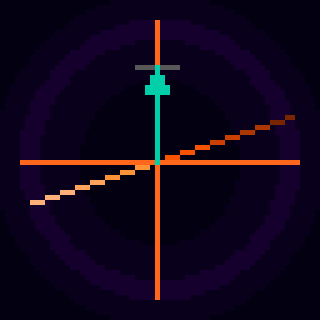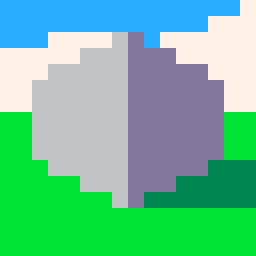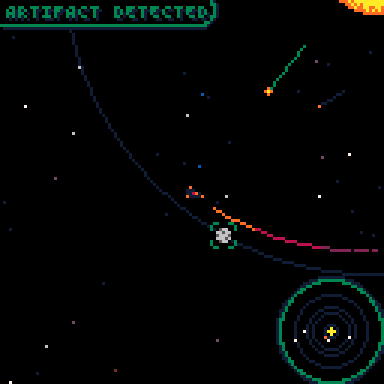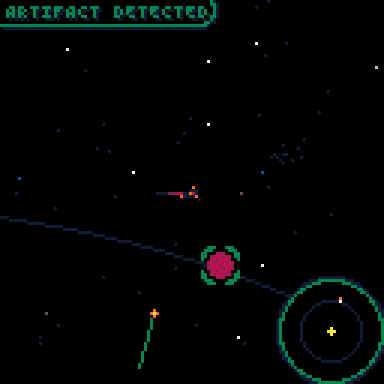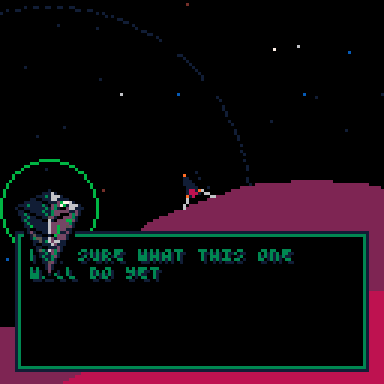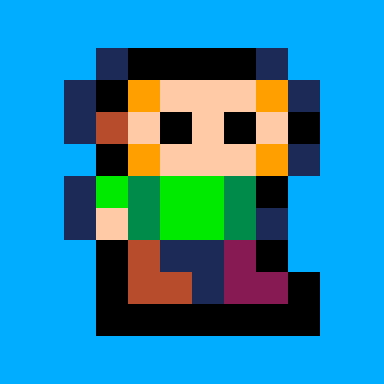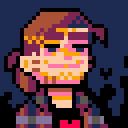Orbital v1.0
Story:
In the distant future, an AI-piloted ship arrives in a distant star cluster. Its mission: to search for signs of intelligent life. You are that AI.
Gameplay:
Navigate star systems and land on planets searching for clues to what happened to a long lost civilization. As you discover alien artifacts, you may gain abilities. Absorb special minerals on the planets to replenish your energy. No enemies or time limit, but watch your fuel levels and don't crash into a star or a planet surface (nose-to-ground collision).
Controls:
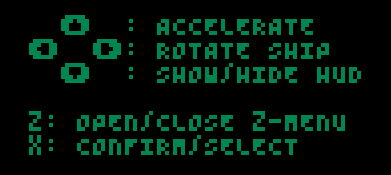
Saving:
This game supports saving/loading. It should work in the web version depending on your browser settings, but it definitely works if you grab the cart and run it locally. Will save automatically after the intro text is read, and after each artifact is found. You can also save through the in-game menu under "options" at any time. If you save in space, you will load exactly where you were, but if you save while on a planet, you will reload back in space where you were when you encountered the planet.
Notes:
Those familiar with KSP will adapt to the controls easily. Others may struggle with navigating gravity wells. For now, see the tips below. Please let me know how it feels to you, or if at any point you're unsure what to do next.
Size:
This game uses no map and almost no sprites. The entire star cluster is 65,536 x 65,536 pixels in size, so there are huge distances between stars. And the planet surfaces are about 32,768 pixels wide. Everything is generated procedurally, based on a seed chosen when you start a new game, so the star locations and planet surfaces are consistent and unique to your save game. 8192/8192 tokens used. 99.14% compressed size.
Tips on Orbital Mechanics (how to fly a spaceship):
-
After you start, try accelerating just a little bit, then wait. Watch how your orbit is affected, and see how your speed corresponds to your orbital distance.
-
Use the acceleration sparingly. Small bursts. Unless you are accelerating away from a star toward interstellar space.
-
When in orbit of a star, accelerating in your direction of travel will increase your orbital distance on the opposite side of your orbit. Decelerating will reduce that distance.
-
Also, increasing orbital distance slows you down, decreasing orbital distance speeds you up.
-
Combining the above two ideas, if you are behind a planet and want to catch up, slow down a little bit. This will make you fall slightly closer to the star, making you speed up. And vice versa: if you are in front of a planet, speed up a little. It's counter-intuitive, but it works.
-
Accelerate/decelerate at the lowest or highest points in your orbit. This is where you can achieve the greatest change in your orbits vs fuel cost.
- BE PATIENT.
Good luck!
Updates from last version (0.9)
- Lore added. (Still subject to change)
- Z-menu now has "Stellar Cartography" at the top for faster access
- Mini-map appears as soon as you enter a gravitational well.
- Updated ending animation.
Bugfixes
- 4/11/22: fixed bug when crashing after running out of gas

I am loving the music but I am absolutely not figuring this out, @UnitVector.
I'm probably not alone.
It seems to me you have made a highly realistic spaceship and gravity simulator that absolutely follows the real laws of the universe regarding thrust, gravity, and spatial bodies.
Because of this I'm so inept I can't even figure out how to leave orbit without smashing into its surface.
Your game is highly realistic - but I can't figure out how to play it, not really.
So, yes, a tutorial would definitely be desired.

@dw817 Yes this game's physics are a realistic simulation of Newtonian gravity and represent what it would actually be like to pilot a spaceship (in compressed time of course).
I've just added some orbital mechanics hints to the main post.

Really nice! I love the concept, and the music and visual style are both on point. I'm excited to see where this goes.
If you're open to a bit of feedback - I've gone far enough to have explored two star systems (my starting one and one other) and found one artifact (in my starting system). I have played a reasonable amount of KSP, though it's been years since my last session. A few notes:
-
Doing all maneuvers by feel, with limited visibility and very little UI assistance, is kind of frustrating. I'm not sure what the exact most useful indicators would be, but a plot of my current orbit in the mini-map would be useful, as would apoapsis/periapsis position indicators in the main window. (Apoapsis more so than periapsis, I think.) The minimap plot would help with transfers, apoapsis would help when trying to alter orbital phase or when circularizing after entering a new system. When I get near a planet in system view, an indicator of velocity relative to that planet would also be super helpful.
-
It would be very nice to have some time acceleration controls. Being short on fuel and having to wait many orbits to catch up with a planet since I don't want to make big corrections is not a great experience. Related: a clearer indication of distance to the next system would be helpful. (Also, there's a bit of a "how much fuel do you want to burn to avoid wasting your time" decision there which, I dunno, is a little too idle-game-ish for my taste.)
-
In the star chart, it might be nice to see an indication by each planet of whether I have scanned that planet or not? I'm a bit worried that I might end up missing an artifact, since going back over ground I've already covered seems like it'd be a very slow process, and as of right now it seems like the only reason I'd come back to an already-visited system is if I've made a mistake. edit: oh no, planets don't show up in this view if I never got close enough to them. I'd definitely rethink this - the idea that I could end up with an unscanned planet in some random system on the other side of the map and that there would be no way to figure this out other than revisiting everything is really discouraging.
- I don't want to spoil the game for myself, and I notice that you say the story is still in progress, so maybe I'm commenting on something that just isn't present yet. That said: I think I'm looking for the story to have kicked in a bit more firmly by now, or for the first artifact to have done something beyond present a cutscene. (Or maybe it did and it just wasn't very clear?) The planets to scan / artifacts to find ratio is pretty high, which I think means the story will have to do a lot of lifting, or new mechanics or other surprises will need to show up.

This is an amazing achievement. I remember trying to write a 2D fly around a solar system thing in Turbo Pascal on my 486, and I just couldn't communicate enough even with all the pixels of a 640*480 screen to play with.
Back then I hadn't played KSP, and I do agree that having played that helped a lot.
Initially I was just going to try flying to one other system and landing, because exploring all the planets looked tedious. However, @luchak:
I'm really impressed by the amount of animation polish from the start menu to the ending. For people who have picked up a few artefacts and wonder if it's worth continuing to the end... it takes an hour or so, but it's pretty cool.
I played all through in a single session in the Web player. After finishing, I confirmed that my saved game was properly stored in the browser. (I'll probably find it gone when I restart the browser, but I think that's due to my choice of privacy settings.)

@luchak Thanks! This is great feedback, some of which I already had in mind. Showing a representation of the trajectory in the minimap is something I want, too, and time adjustment was something I wanted from the start. The main issue is I've been hitting the maximum code budget in tokens and compressed size over and over, trying to reduce code just to get in the necessary stuff, and so I don't think I can fit much more in the game. (I've got about 10 tokens to spare right now). Also, time adjustment (skipping frames) would introduce some significant inaccuracies in your orbital trajectory, due to the size/accuracy of the numbers involved. Maybe I could temporarily switch to 60 fps for 2x speed?
About periapsis and apoapsis indicators, I look at my velocity for that. I watch when my velocity stops increasing and starts decreasing for my periapsis, and vice-versa for apoapsis.
About distance to the next system, the radial lines at the edge of the screen indicate distance. Length of line = closer. Dark gray = far, Light gray = close, Green = inside gravity well.
About relative velocity to planets. This would take a lot of tokens to get, and another issue is screen space in which to display information. Tucking in enough information to navigate on this 128x128 screen was difficult to manage. And I figure you can gauge that pretty well with your eyes/relative orbital distance/etc.
As far as the star chart, with 0 and 1 artifacts found, only the planets you've scanned show up on the star chart. After the second artifact, all planets show up on the star chart. I did consider putting an indicator to show which you have scanned, but after your 3rd artifact, all the artifact locations are shown, rendering that indicator pointless.
I am seriously considering making a larger version of this game in Unity, and as such have been thinking of this as a demo, or just an exploration of a concept. A larger game would have more distinct planets, more stuff on the planets, comets, asteroids, more lore, time acceleration, better controls, better visual indicators, etc.
Thanks again for playing and for your comments. I'll see if I can squeeze some of this stuff in.

@Cowirrie Thanks for the compliments and the feedback. I'm super impressed you were able to finish it in one play.
As for your first point about putting two in the first system. I wanted players to have to explore slowly at first, not knowing what they'd find and where. I wanted them to have to figure out the navigation by feel and get better at it, then reward them by increasing the pace as you go. Sometimes it takes exploring a few systems to find a second one, which can get tedious, but I think it's fun. (shrug) I wanted the player to feel a sense of mystery at what they might find at that unexplored, unknown system in the distance.
Navigation aids like periapsis/apoapsis indicators would be nice, and as I said in my response to luchak, I both plan to add them in a larger version and also feel that velocity can be used to indicate these in this version. All the information necessary to feel these out is given.
Yes, the planets have different gravity strengths based on their mass. And though it may not seem like it, there is some variation in the overall smoothness/spikiness of the surfaces. It's difficult to make that value change on the same planet within this code budget, but that will definitely be a feature in the larger version. I also plan on adding more surface features in general, and more planet types.
Did you travel around by slip tunnel in the second half? Really speeds up travel in interstellar space, by a LOT.

@UnitVector Thank you for the detailed response! Your points make a lot of sense, especially re: token count ... there's a lot going on in this game. If I were to prioritize my suggestions, I think I'd stick with these two:
- Time acceleration available either from the start or very early on. This would take out most of that "how much fuel do I burn to not be annoyed" tradeoff both in orbit and in interstellar flight, making it feel better to focus on efficient fuel usage. The max multiplier could still be low-ish to make later upgrades feel impactful, but something in the 3-5x range might be good. Instead of increasing dt, if updates are sufficiently cheap, you could just call the existing update function multiple times per frame? Agreed that having the physics change when time speeds up doesn't seem great.
- The first artifact should resolve some minor annoyance or difficulty that I have already felt. (If it already does this, I didn't notice!) This is less about becoming more powerful earlier in the game, and more about setting player expectations. As it was, when I didn't notice any changes after the first artifact, I assumed that none of the others would do anything of note. Combined with the fact that the first few planets I visited seemed fairly similar other than artifact presence (craggy landscape, ore/fuel pockets) this took a lot of the appeal out of exploring.
Of course, this is just my take, feel free to ignore if it doesn't fit with the vision or the token count! Now that I know to expect upgrades I might give this another shot.
A couple of other assorted responses:
- Looking at the velocity for apoapsis is a good point ... it's still a little rough but it's not something I was doing and it would definitely help.
- For planet-relative velocity, I think the thing an indicator would help with is less instantaneous velocity, and more making it easy to visualize planet-relative acceleration when star-relative velocity is large but planet-relative velocity is small. (Do I need to do a turn-thrust-turn kick to intercept while avoiding crashing or can I just let things go?) Not a huge deal, though, especially if it's a big token cost.
- I would love to see an expanded version of this game!

@UnitVector Yes I enthusiastically used the Slip Tunnel as soon as I got it. If you had the luxury of many more tokens, it would be good to give it risk to go with the reward - that it's easy to hurt yourself with it.
The first few times I covered interstellar distances, I arrived painfully short of fuel, and in one case ran out and got a game over. Would you consider making it so your ship has "solar panels" that recharge energy when swinging close to a star, maybe to a limit like 25% of total capacity? Or is an important part of the design that travelling between stars involves careful rationing of energy, from the moment you depart?
Regarding the jaggedness of planets, I'm afraid I hadn't noticed the variation. But it also doesn't matter much, because you can land almost anywhere up to a 45-degree slope. What I'd like to see is for the slope to matter - that some slopes are too steep, there are flat surfaces here and there, but some are at the bottom of steep pits. Like the landscape in the vector graphics Lunar Lander.
It's easy to play this and get inspired with grandiose ideas for what else could go in it, and I agree that a game like this made in Unity could have many more clever things in it. But it's still amazing what you made the PICO-8 do, and I hope it helped you think about what parts of the design mean most to you.

-
So, I think I might actually be able to incorporate the time dilation thing, if I can make the token space for it. I think it would be computationally cheap enough to do two physics calculations per drawn frame. The token cost would come in auto switching back for certain events, like the end game, or going to 'warp'. Situational state switching can be expensive. As far as fuel usage, the 3rd or 4th artifact cuts your fuel usage in have, so you can be more dramatic in your delta v's. Before that, you do have to be a little frugal with your fuel usage, but I put a lot of time into giving it a balance I thought was fair but challenging. I'll take you experience into account and maybe alter the fuel usage rate a bit. But consider spending less time thrusting. I usually limit myself to about 70km/s when travelling interstellar.
- The reason you didn't notice it after the first artifact is that it happens after the second artifact. Guess I wasn't clear on that. The first one just gives you a hint of lore, which will be fine-tuned later. As far as the appeal of exploring, since once you find two you don't really have to explore anymore, it becomes a non-issue pretty fast. Also, since you can tell from orbit if there's an artifact or not there's no reason to explore planets anyway unless looking for the artifact you already know is there. So I didn't put much into making the surfaces interesting.
Now that I think of it, since I am checking for distance to planets each frame when close, I could easily compare previous frame to current frame distances and get a relative velocity reading, but where and how should I display it? Also, I'm not really understanding why it's needed. There is no danger of crashing on planets from orbit. You can collide with them going super fast. No different from a soft approach. I intentionally made the game very forgiving on collisions.
Thanks again for all the comments.

@Cowirrie I kind of decided that I wanted the game to be pretty forgiving in most respects. Since sometimes it takes a long time to travel around I wanted to minimize the risks of failures.
That being said, the fuel thing is something I spent a long time balancing. Most people want to spend a lot of fuel getting up to some high speed when traveling interstellar, then have to spend a lot of fuel slowing down so they don't fly right through the next one. I'd hoped the player would figure out that they should then be a bit more frugal with fuel, and just let it take 2-3 minutes to fly to another star in the beginning. The story begins with the idea that this AI took thousands of years to get here. I wanted the player to 'feel' that these distances are large. I wanted a lot of it to be about feel rather than info or control. In space travel, patience is how you get places, not thrust. You let gravity do the work, not your engines.
Solar panels isn't a terrible idea. They could charge you based on distance to the star. Would incentivize zooming down close to them, making for exciting flights. I may add this in. But how to let the player know it's happening? Also, I want the player to have to perform orbital maneuvers to encounter planets for the purpose of refueling, since the orbital maneuvers are the main mechanic of the game.
As far as landing on slopes, you'll find that if only one foot lands, you will slowly tip over until you crash, or land, depending on your angle. I wanted to make this happen even if both feet hit the ground, but the issue is this.. There are events triggered by both feet hitting the ground. One event is the artifact message box opening. I had to make it so that when both feet touch, they stick. You find that if you are going fast enough, you can land almost sideways, as long as both feet went into the ground. This is something I just had to accept as a quirk due to the limitations of the machine. Doesn't matter how fast you're going when you hit the ground either. I didn't want to punish the player too much so I'm super lenient on crashing. If your nose hits the ground, though...
Basically it all boils down to the cart size. I had to choose what I could afford to put in and what I had to just say is good enough. All this will be addressed in the larger version, if I make it. Thanks for thinking about it so deeply and for giving this feedback. I really appreciate you playing my game. You are the first to finish it, btw, so there's that. :)

I really appreciate the discussion! The reason I'd suggest having the first artifact make some meaningful difference is basically so that players learn from the game instead of from you - and I think it would make that first discovery feel much more impactful, even if the actual change to the mechanics is small. It would really drive home "artifacts do stuff, go find the next one!" and make the ramp-up more compelling, I think. I actively learned the wrong lesson from the first artifact - I was wondering if it would do something, because that seemed natural, and when it didn't I sort of assumed that was just how artifacts were.
Or maybe another way to approach this would be to communicate in the story that the first artifact is broken or flawed somehow, and hint that the others might be different? Or have the first artifact act like it's going to do something big and meaningful, and then, I dunno, it explodes or just goes dark or something. Basically do something to indicate that the next artifact is likely to do something more interesting.
I mean, I know the situation now, so I'll go find 'em! I'm trying not to read too many of your other comments in the thread so I don't get too spoiled. :)

@luchak That's a great point. I'll keep that in mind and talk to my friend that's helping me with the lore.
I guess I figured the player should encounter the first one within a few minutes of play and so wouldn't even notice any change in play since they're not used to the game yet anyway. And I guess it wasn't clear that what the first one does is give you the ability to read the artifact makers' language, and also tells you outright, "I must find the others". I hadn't thought that this wouldn't be enough to make players want to find more. I thought curiosity would be enough. I'll do some thinking about what the first one might do.
I had at one point thought I'd have the first few reveal the 'next' one. However since they are procedurally placed, it'd take a lot of code to get it to give you the next 'closest' one. If I just picked the next location in the list, it might be all the way across the map, when there's another one the next star over.
I'll do some brainstorming. Thanks again.

"Solar panels isn't a terrible idea. They could charge you based on distance to the star. Would incentivize zooming down close to them, making for exciting flights. I may add this in. But how to let the player know it's happening? Also, I want the player to have to perform orbital maneuvers to encounter planets for the purpose of refueling, since the orbital maneuvers are the main mechanic of the game."
I can see you wouldn't want to entirely bypass the planetary surface collecting part, which is why I suggested that solar panels could only fill your energy to some fraction of the total, like a quarter.
The design I'd like would be so that:
- If I manage to enter a system but I'm nearly out of juice, as long as I can set up a cometary orbit, I can get enough fuel to reach a planet but not to breeze off to another system.
- If I repeatedly fail to match orbits with a planet and I've wasted all my fuel, I can recover by lowering my apoapsis. But in doing so I also throw away my nearly-matched orbit, and have to start over.
I gather it was complete luck that the first system I flew to had an artefact. I wonder what the probability of that was.

@Cowirrie
I do like the solar thing, but why would it only charge you 1/4? Why would it not charge you all the way? That doesn't really make sense, I feel.
Hmmm... maybe some intro text explaining your solar cells became damaged in the long journey and so you can only charge a certain amount, but absorbing the minerals can get you the rest of the way. That might be good since I never explain about the minerals anyway and some people told me they didn't know how to refuel. And maybe I can make one of the artifacts fix your solar panels so you can charge all the way...
Oh, and there are 24 stars and 8 artifacts, so the probability is 1/3.

Love the discussion. Such complexity in such a limited platform such as PICO-8. Haven't played a lot of the game so far, but just wanted to say how much I love the music. Very atmospheric and matched the game perfectly.

I haven't played anything like this before, this was a blast! I played it in one sitting, half-working on other stuff in-between stars. Chill stretches in between bite-sized and surprisingly intense navigational challenges, had me on the edge of my seat trying to use my last spoonful of fuel to line up with a planet several times. It's slow, but I was exactly in the mood for it

@biovoid Thank you so much. I worked really hard on the music and I'm so glad you enjoyed it. It's always amazing how working within limitations can fuel creativity, and I tried to make the most out of some simple themes. You might have noticed the elements in the tracks sometimes loop at different rates (fast parts on slow parts, or a 12/8 or 14/8 on top of 4/4 or 3/4. This was meant to embody the idea of the different orbital periods of planets. The final version may have one or two more tracks.
@Droodle Wow. I'm so glad you found it enjoyable enough to play all the way through, even though the lore is still missing. It is slow at times, and that's by design. I realize lots of people may not enjoy the parts that require patience, but I like those bits, and that's what the reality of spaceflight would be. Real spacecraft missions don't burn fuel to get places fast, they minimize fuel use and employ gravity to make long efficient journeys. Thanks so much for your comments.

I beat the whole game as well, the music was good enough that I kept at it in the slower early game (I had to visit something like 5 stars to find my first artifact...). This game was very unique and fun, and the artifact powers definitely helped accelerate things as you got further into it. I do have a few small suggestions though, and apologies if some of this has been mentioned above. I wanted to comment without being too influenced by other people's experiences.
One thing that really bugged me was the fuel menu. Every time you open the star map, visit an artifact, etc, the fuel sidebar turns off, and stays off when you leave that other menu. Since understanding fuel levels is so crucial, it was a lot of tapping down to get that menu back, so I think the game should remember what the current setting is and do that automatically. Possibly also draw the current fuel level on the ship, or change the color/amount/distribution of fuel particles ejected at certain levels.
Also, I still don't understand what the three fuel bars were for. Just a shading gradient? This was confusing to me, since they seemed to be at different heights, but the leftmost one was always the highest.
Regarding z menu layout, I'd put stellar cartography at the top (so you can just zxx to get to the starmap quickly, since it's the most used feature). Also, after you get the warp speed, I'd prefer if it permanently mapped to X after you select it once, so I don't have to keep going back into the engine menu every time I want to adjust my trajectory. Maybe equip it, if you want multiple functions mapped to that button?
On the gameplay side, outer planets are currently much harder to scan and land on in the early game, because the solar system map disappears if you go just a bit outside of their orbits. Maybe draw the minimap until you leave the gravity well, and just snap the player dot to the circle's edge?
My strategy for gameplay also ended up being different than you probably wanted. I would boost to 80+ through interstellar space, directly at the next star, and then save my game immediately when I entered the new gravity well. Then I'd use what was left of my fuel to decelerate and launch at a planet, and if I missed I'd just reload. This was largely due to impatience after going through a few systems with zero artifacts in them, so maybe you can detect the closest system adjacent to the starting one, and always seed one there.
I did notice that you're near the token and compressed limits though, so not sure how much more you can add. A double-splitter function might help for data, and also direct use of locals that only get used once (like removing s and s2 in spiral_in), but it seems like you're close to the limits of readable code. I just want to say that the game is great as-is, and likely doesn't need many changes at all. Please don't get bogged down in the optimization pass and token reduction, this just needs a little more content and polish to be an excellent finished game. :)
I will post a double splitter though, in case you're interested. It makes it possible to set up a lot of your constant locals in a single string, for 2 tokens, which should reduce a lot. (I made the assumption that empty sections in the first split should be empty arrays too, since nil is always an unnecessary initialization.)
function split2x(s)
local a=split(s,";")
for i=1,#a do
local e=a[i]
if(type(e)=="string")a[i]=#e>0 and split(e) or {}
end
return unpack(a)
end
--local angvel,thrust,exhaust,gr,particles,shipscale,extend,l_l=.01,{0.024,0.48},{896,64,72},{0.1,0.2,0.4},{},{5,7,10},0,7
local angvel,thrust,exhaust,gr,particles,shipscale,extend,l_l=split2x".01;0.024,0.48;896,64,72;0.1,0.2,0.4;;5,7,10;0;7" |

@shy
Thank your for playing, and for the very thoughtful suggestions. These are great ideas.
-
Moving the stellar cartography to the top is a very good idea, and I will probably do that in the final version.
-
The fuel menu not popping back up after an artifact visit is a thing I thought about. Making it go away so the artifact seemed like an important visual experience while also semi-taking control of your ship was something important I wanted to do, and having it come back seemed like it might be code expensive so I didn't. On more thought it probably wouldn't be difficult. I'll see what I can do.
-
Fuel colors. I did that because it was boring as hell with one color and a flat top. Didn't realize it would be confusing, but now two people have mentioned it. I only included the same colors as on the minerals and also in the exhaust so I figure it would make sense. I'll think about changing it.
-
About drawing the player's position snapped to the edge of mini-map: I didn't want to reduce the scale of that mini-map any more or make it bigger, covering more of the screen. I put a lot of thought in about snapping to the edge but thought it might confuse the player when they suddenly start flying through the mini-map when they were just stationary on the edge, and decided to just not include it. I may just extend it's range a little further to help with outer planet navigation.
-
About seeding the next planet in-game so you don't have to search far:, this is a point of difficulty. The amount of code and work that went into defining the star system with the random seed is so involved that redefining it in gameplay is extremely difficult. Also, being inspired by KSP, I wanted the exploration itself to be the fun of the game, not fast completion. In that game, you could play for 100 hours before finding any of the hidden artifacts. But it's still fun. I had hoped to capture some of that. This was something I knew would be unconventional, especially on Pico-8 where games are usually quick and short. I have just decided to accept that some or even most players wouldn't like that.
- This double splitter technique is definitely something I'll look at and try to implement. I already to a double split on the lore, with ALL the lore saved in 1 string and split at startup by artifact, then screen of text. Thank you for this. Maybe I'll be able to put in some more features or fine-tune some things.
Thanks again for the time you put in, and I'm so glad you enjoyed it.

This was really fun! Amazing game. I love orbital mechanics (KSP fan here) Great music. Played the whole thing through.
May be a bug, but after the end (i'll not write any spoilers here) the screen stays black, i.e. doesn't go back to the menu but freezes the game?
Suggestions (some already mentioned above):
- A trajectory in the mini-map would be really helpful.
- A quick menu for accessing the star map and the slip-drive directly from the game? The X key is still free, right?
[Please log in to post a comment]





